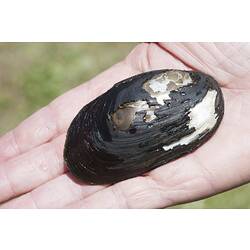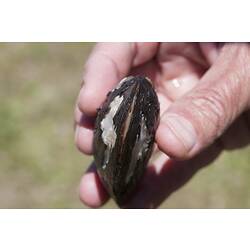General Description
Three species of Hyridella occur in the coastal rivers of eastern Victoria. They are longer than they are wide and are quite deep bodied. All possess the dark horny outer layer on the shell and are distinguished on slight differences in their shell shape, muscle attachments and gills. The shell ranges in size from 3.5-9 cm.
Biology
Freshwater mussels are filter feeders and live burrowed into the sediment so that only part of their shell remains visible. Water is drawn via siphons into the gills where oxygen is extracted and food particles are filtered out. Newly released eggs hatch into a larval stage that is parasitic on freshwater fishes. This stage gets carried by its fish host and eventually detaches to change into the typical shell form that settles in the river bed. One species in this genus, Hyridella glenelgensis, is considered critically endangered in Victoria.
Distribution
In coastal rivers of eastern Victoria and southern New South Wales.
Habitat
Rivers and streams. Burrows in soft sediment, often at the edges of the water.
More Information
-
Animal Type
-
Animal SubType
-
Brief Id
A freshwater mussel with an elongated two part shell and a dark brown to black horny layer on the outside, sometimes scraped off near the hinge of the shell.
-
Colours
Black, Brown, Silvery-white
-
Maximum Size
9 cm
-
Habitats
-
Diet
Organic matter
-
Endemicity
-
Commercial
No
-
Taxon Name
-
Common Name
Freshwater Mussels
-
Phylum
-
Subphylum
-
Class
-
Order
-
Family
-
Subfamily
-
Genus




